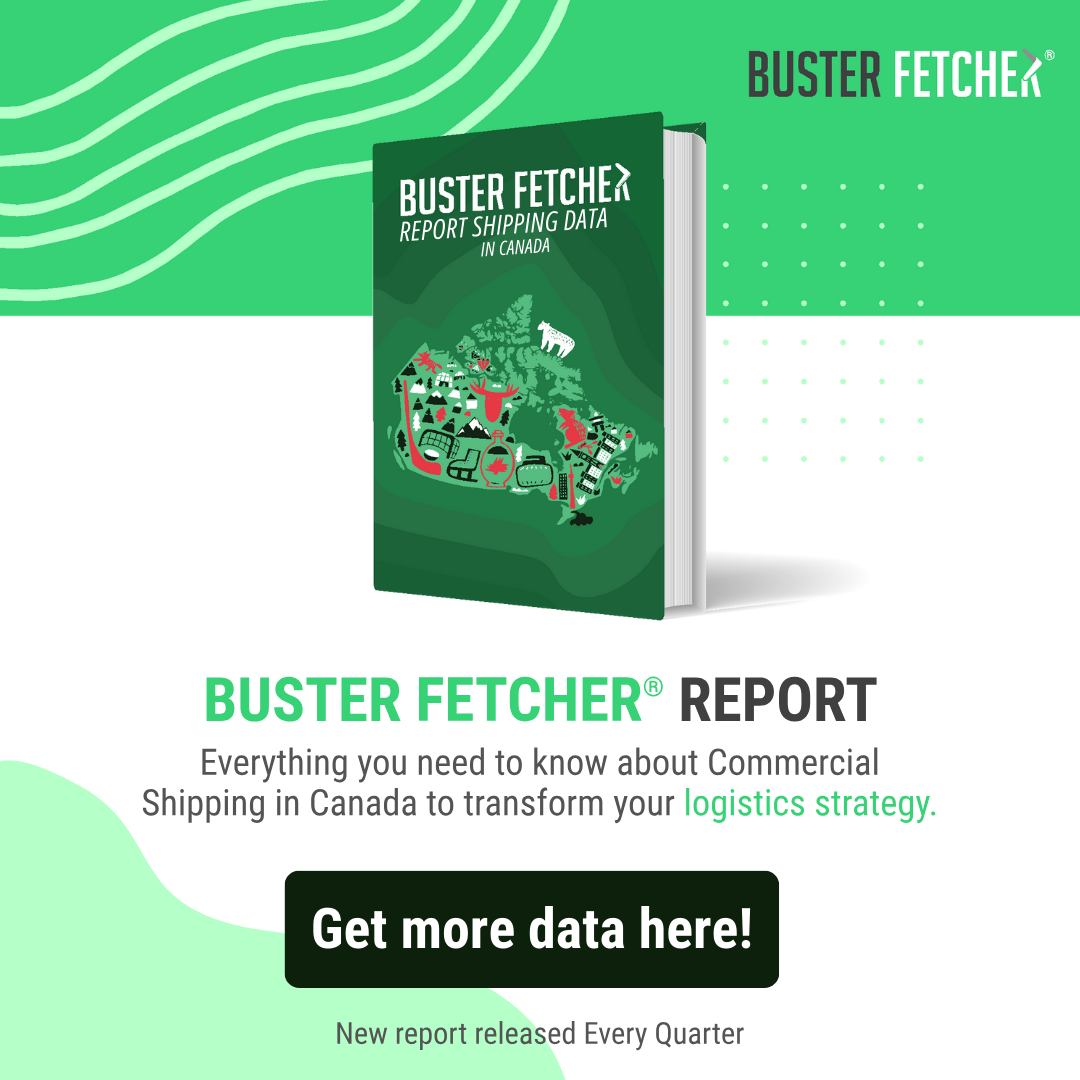Q3 2023 Data: Stop Leaving Money on the Table with Unused Shipping Labels
Published on November 11, 2023

Oops! Did a shipping label you bought get buried in your inbox and never make it onto a package?
You’re not the only one!
It’s a tiny thing that many of us might not even blink at, but here’s a nudge—those little labels can add up to one big dent in your finances.
Imagine if every unused label was a coin dropped into a jar. It might not seem like much day to day, but over time, you could be looking at a jar full enough for a little celebration. Now, we think it’s better if that celebration is in your honor, not because of overlooked labels.
Cue the Buster Fetcher Report Shipping Data! We’ve been busy bees, examining a massive 1.7 million parcels crisscrossing with Canada Post, FedEx, Purolator, and UPS.
And guess what? We found a stash of unused shipping labels—a silent budget buster that’s more common than you’d think.
Let these findings help you find ways for your business to keep those unused labels—and your money—from slipping through the cracks!
Table of Contents
Percentage of Businesses That Purchased a Shipping Label but Never Shipped the Package
How to Unlock Label Efficiency With Six Smart Strategies
Conclusion: Ready to save money checking your unused labels?
Percentage of Businesses That Purchased a Shipping Label but Never Shipped the Package
- Widespread Issue with Canada Post: Across all provinces with data, Canada Post consistently has the highest percentages of unused shipping labels. Nationally, a staggering 38.30% of labels purchased from Canada Post are never used for shipments.
- Quebec's Exceptional Rate: Quebec has the highest non-use rates for both Canada Post (43.97%) and Purolator (42.06%), suggesting a significant number of businesses in the province are buying labels but not proceeding with shipments.
- FedEx's Efficiency: FedEx consistently demonstrates the lowest non-use rates across all provinces, with several regions (Alberta, New Brunswick, Nova Scotia, and Saskatchewan) having 0% non-use.
- Notable Observations in Ontario: This province, which is crucial for business, sees 34.44% of Canada Post labels and 21.39% of Purolator labels going unused. In comparison, FedEx and UPS have significantly lower rates at 7.69% and 15.3%, respectively.
- Inconsistencies with Purolator: While Purolator has a relatively high national average of 27.70% for non-used labels, the rate varies widely from province to province, ranging from 8.82% in Saskatchewan to 42.06% in Quebec.
Shippers and businesses should be cognizant of these rates, especially when using Canada Post and Purolator, as the high percentage of unused labels indicates potential inefficiencies or oversights in the shipping process.
How to Unlock Label Efficiency With Six Smart Strategies
Our latest Buster Fetcher Report Shipping Data has cast a spotlight on an area ripe for optimization: shipping label usage.
With a significant percentage of labels going unused, particularly with Canada Post, it's evident that there's room for improvement in shipping practices.
Check out these smart ways to address this issue and ensure that every label (and dollar) counts!
1. Streamline Your Shipping Workflow
Buster Fetcher can assist in tightening up your internal processes, significantly reducing the number of unused labels. Our system tracks the purchase and utilization of labels, ensuring none are forgotten.
Here's how our solutions can educate and transform your label management:
- Intelligent Label Tracking: Understand the lifecycle of each shipping label with our comprehensive tracking system. It ensures every label you buy is put to use, preventing any from being overlooked.
- Data-Driven Audits: Benefit from regular audits that provide actionable insights. Our tools scrutinize your usage patterns to highlight and help correct inefficiencies, turning potential losses into savings.
- Preventative Solutions: Learn how to preemptively address common pitfalls in label utilization. We provide you with the knowledge to stop label wastage before it starts, streamlining your shipping processes.
2. Adopt a Just-in-Time Approach
Timing is everything. Purchasing labels right when you need them can cut down on waste, keeping your operations lean and mean. Let's nip those unused labels in the bud with a just-in-time approach:
- Align your label purchases with your shipping needs. Buy labels when your packages are ready to go, ensuring you're not stockpiling unnecessary labels.
- Keep your label inventory streamlined. Avoid accumulating excess labels that might go unused. Think of it like keeping your fridge stocked with essentials, not overflow.
- Incorporate label purchases seamlessly into your shipping routine. Modern tools can automate this process, making label procurement an efficient part of your operations.
- Flexibility is key. Adjust your label buying to match your shipping volume. Some days, you'll ship more, and on others, less. The just-in-time approach allows you to adapt to changing demand.
3. Leverage Carrier Efficiency
For instance, FedEx is doing something right with their low label non-use rates, and there's wisdom to be gleaned there! Taking a page from their book could be beneficial. Let's uncover the secrets to their success and how you can apply them to your business model!
- Real-Time Tracking: FedEx offers robust real-time tracking solutions. Emulating their approach can provide you with better visibility into your shipments, reducing the chances of unused labels due to uncertainty.
- Customized Services: FedEx provides a range of services tailored to different business needs. By adopting a similar approach, you can align shipping services with your specific requirements, optimizing label utilization.
- Effective Label Management: FedEx's label management systems are highly efficient. Implementing similar systems can help you keep tabs on your labels, ensuring they are used effectively.
4. Customize Solutions for Regional Challenges
When it comes to label usage, regional differences matter. One strategy doesn't fit all, especially in diverse regions like Quebec and Ontario.
Quebec, for instance, has notably high non-use rates for Canada Post and Purolator labels, while FedEx excels in operational efficiency across provinces.
In bustling Ontario, optimizing label management is crucial. To navigate these regional nuances, tailor your shipping strategy to each area you serve, ensuring labels are used effectively.
5. Educate Your Team
Empower your shipping team with knowledge. Make sure that everyone involved in your shipping process fully understands the financial impact of unused labels.
Building awareness and fostering a culture of cost-consciousness within your organization is crucial for optimizing your shipping practices.
6. Opt for Digital Solutions
Embracing digital tools that offer real-time shipping label management can provide greater control and oversight. Look for platforms that integrate with your current systems to streamline operations.
Conclusion: Ready to save money checking your unused labels?
Remember, those seemingly small unused labels can add up over time, impacting your bottom line. It's time to take action and make the most of every label and dollar.
But you can turn those unused labels into real savings with Buster Fetcher's practical insights and smart strategies!
Streamline your workflow, adopt a just-in-time approach, learn from FedEx's efficiency secrets, tailor solutions to regional challenges, educate your team, and embrace digital solutions for better control.
It's time to celebrate your shipping success, where every label finds its purpose, and every dollar is put to good use. Explore the full Buster Fetcher Report for even more valuable shipping insights and together, let’s win the shipping game!




